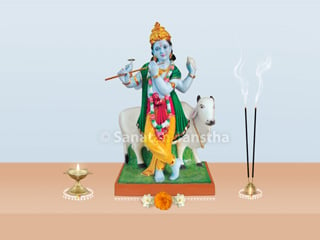In today’s times, when intellect dominates the actions of the majority of the society, most of us are unaware of the real purpose of this precious human birth.
Dharma preaches us that the purpose of human birth is God-realisation. In order to realize God we should undertake spiritual practice. The religious scriptures therefore impart guidance on how to undertake spiritual practice so as to be able to get closer to God in every incident of life, right from birth till death. Life span from birth till marriage completes one cycle. A similar cycle is completed from the birth of a son/daughter to his/her marriage. This goes on generations after generations. Certain sanskars, as explained in our scriptures should be performed by an individual to get closer to God in the sixteen rituals in life from conception to marriage. These sanskars later help in improving spiritual practice.
There is a spiritual reason, a science underlying each particular action undertaken during the performance of each of these sanskars. When we realize the true science underlying the sanskars and the rituals, and perform them accordingly, we come closer to God.
The details of rituals may differ from class to class, caste to caste, sub-caste to sub-caste etc.
1. Meaning of ‘sanskar’
The Vedic rituals performed by the mother, father and the Guru on the son or daughter from the time of conception till marriage, so that they may perform balanced sattvik actions are referred to as the sanskars. There are sixteen important sanskars. Sanskar is a process of increasing the potential in ourselves. The word ‘sanskar’ has multiple meanings, such as – to improve, to purify, to remove shortcomings in an object and to endow a new, attractive form to it.
In short, the process by which positive qualities in man are developed and enhanced is known as a sanskar. The spread of the concept of sanskars and their number is widely discussed in the Gruhyasutras (Holy texts of Hindus).
2. What is the Importance of the sixteen sanskars?
A. The sixteen sanskars in Hindu Dharma is the medium offered by God to the individual to generate Chaitanya (Divine consciousness) in their day-to-day life.
B. As the individualis able to expand the horizons of its mind through sixteen sanskars, it becomes easy for the individual to come out of worldly emotions and enter the world of bhav (Spiritual emotion).
C. Through the flow characteristics of Chaitanya, seeds of sanskars are sowed in the subconscious mind of the individual. The process of relay of frequencies of Raja-Tama oriented seeds of impressions of many past births is effectively countered by the process of the sixteen sanskars prescribed by Dharma, thus eliminating the related thought processes.
3. Philosophy and science underlying the sixteen sanskars
‘Sages of yester years focussed their efforts on every individual for the overall progress of mankind. Complete spiritual evolution resulting from the sanskars benefits the individual. The individual can gain all-round prosperity and is able to lead a courageous and happy life and also contribute to the spiritual evolution of the society. This would lead to strengthening of the society, which in turn would contribute to the prosperity of the Nation. Should this process continue unhindered in the society, the society in turn would help every individual become worthy. With a view to give boost to continuation of this process, the arrangement of sixteen sanskars has been developed. The sixteen sanskars from birth till death are suitable as per the prevailing age of the individual and the circumstances.’ – H.H. Parashram Madhav Pande Maharaj, Sanatan Ashram, Devad, Panvel.
4. Stages in the creation of an earnest desire for sanskars
A. A life full of sanskars means to be thinking about God with all His original attributes as described in Hindu Dharma.
B. Thinking about God develops a liking for devotion towards God.
C. Through devotion, develops an attraction for God-realisation.
D. Through earnestness the ultimate sanskar that ‘God realisation’ is the goal of life is imprinted on the sub-conscious mind which accelerates the yearning for Moksha (Final Liberation).
5. Stages in the journey of God-realisation
A. Kartrudharma (Code of Duty):
God, first of all, teaches the individual the Kartrudharma in its journey towards God-realisation. It means performing every act of life as per the rules of Hindu Dharma.
B. Karmadharma (Code of Action)
It means understanding and performing the action according to the science of Spirituality.
C. Sanskardharma (Code of sanskars)
It means pondering over the science of Spirituality underlying every karma, making continuous efforts for God-realisation and handing over the vow of the sanskars to the next generation.
6. Special attributes
‘H.H. Dr. Athavale has propagated through this Holy text the three codes of Righteousness – code of duty, code of action and code of sanskars and has propounded the Principle-based process of spiritualising every sanskar in life by explaining how to understand the cause behind every incident in life and how to bring about oneness with God through spiritual practice.’ – A Scholar (Through the medium of Mrs. Anjali Gadgil, 5th January 2006, 12.23 p.m.)

 Maghi Shri Ganesh Jayanti 2024
Maghi Shri Ganesh Jayanti 2024 Partial lunar eclipse of October 2023 – Do’s and Don’ts
Partial lunar eclipse of October 2023 – Do’s and Don’ts Main places of pilgrimage of Deity Datta
Main places of pilgrimage of Deity Datta Photographic Divine vision of some places which have experienced Shrikrishna’s blissful presence !
Photographic Divine vision of some places which have experienced Shrikrishna’s blissful presence ! Jananashanti ritual for baby born in an inauspicious period
Jananashanti ritual for baby born in an inauspicious period Mangaldosh – concept and misconceptions
Mangaldosh – concept and misconceptions